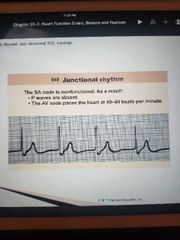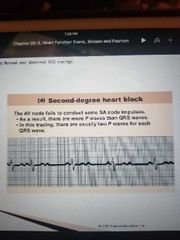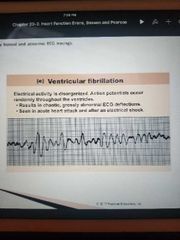![]()
![]()
![]()
Use LEFT and RIGHT arrow keys to navigate between flashcards;
Use UP and DOWN arrow keys to flip the card;
H to show hint;
A reads text to speech;
48 Cards in this Set
- Front
- Back
|
Describe the 2 cardiovascular system circuits |
"Pumps", blood flow: Pulmonary circuit: (cardio) "right side of the heart", LUNGS. Veins: entering the left atrium, carry blood to the heart from the pulmonary circuit. - inferior vena cava, superior vena cava, coronary sinus. Arteries: exit the right ventricle, carry blood away from the heart to the pulmonary circuit. - pulmonary trunk. Systemic circuit: (vascular) "Left side of the heart", BODY. Veins: entering the right atrium, carry blood to the heart from the systemic circuit. (4 pulmonary veins) Arteries: exit the left ventricle, carry blood away from the heart to the systemic circuit. - aorta |
|
|
What is cardiology? |
Cardiology: the branch of medicine that deals with diseases and abnormalities of the heart. |
|
|
What is the interatrial septum and interventricular septum? |
In reference to chambers: Interatrial septum: separates the atria. Interventricular septum: separates the ventricles. |
|
|
Define coronary sulcus and fossa ovarian |
Coronary sulcus: separates the atria from the ventricles (external feature) Fossa ovalis: former location of the foramen ovalis through which blood bypassed the lungs in the fetus. |
|
|
Compare veins to arteries in reference to the coronary circulation |
Arteries: (O2 rich, CO2 poor) Come out of the heart, all arteries except the pulmonary artery are well oxygenated, because it leads to the lungs. - anastomoses: junctions Veins: (O2 poor, CO2 rich) Go to the heart. All veins except the pulmonary veins are poorly oxygenated. |
|
|
Explain the coronary sinus |
Coronary sinus: empties into the right atrium; formed by merging cardiac veins. - ischemia can lead to necrosis |
|
|
Explain the blood flow pathway |
Blood flow pathway: - O2 rich blood enters the heart from the lungs & goes out of the body. - O2 poor blood enters the heart from the body & goes out to the lungs. 2 pumps/circuits: - the right side of the heart pumps blood through the pulmonary circulation, which carries blood into the lungs, where carbon dioxide diffuses from the blood into the lungs & oxygen diffuses from the lungs into the blood. The pulmonary circuit returns the blood to the left side of the heart. - the left side of the heart then pumps blood through the systemic circulation, which delivers oxygen & nutrients to all the remaining tissues of the body. From this tissues, carbon dioxide & other waste products are carried back to the right side of the heart. |
|
|
Define the interpretations of the picture word descriptions |
Sinistrum: left Dextra: right Interventricularis: interventricular Ventriculus: ventricle NL: lymph node N: nerve A: arteries V: veins |
|
|
What are 2 conditions that severely weaken the heart? |
Incompetent valve: blood back flows so heart repumps same blood over & over Valvular stenosis: stiff flaps that constrict opening, heart needs to exert more force to pump blood. - defective valves replaced with mechanical, animal or cadaver valves. |
|
|
What type of circulation is the shortest in the body? |
Coronary circulation- arteries Coronary circulation includes both arteries and veins |
|
|
Describe coronary circulation |
- Functional blood supply to heart muscle itself - delivered when heart is relaxed - left ventricle receives most of coronary blood supply |
|
|
Where do both the left & right coronary arteries arise from? |
The base of the aorta, supplying arterial blood to the heart. - both encircle the heart in the coronary sinus. - branching of arteries varies among individuals. |
|
|
What are anastomoses? |
Junctions, which provide additional routes for blood delivery. Arteries contain many of them. - cannot compensate for coronary artery occlusion. - heart receives 1/20th of body's blood supply. |
|
|
Describe the left & right coronary arteries |
Left coronary artery: branches anterior into the interventricular artery & circumflex artery. - supplies interventricular septum, anterior interventricular walls, left atrium & posterior wall of left ventricle. Right coronary artery: branches to the right marginal artery & posterior interventricular artery. - supplies right atrium & most of right ventricle. |
|
|
What is coronary thrombosis? |
A blockage of flow of blood to the heart, caused by a blood clot in a coronary artery. |
|
|
Describe the coronary circulation in reference to veins |
Cardiac veins: collect blood from capillary beds. Coronary sinus: empties into the right atrium; formed by merging cardiac veins. ... great cardiac vein: of anterior interventricular sulcus. ... middle cardiac vein: in posterior interventricular sulcus. ... small cardiac vein: from inferior margin. - several anterior cardiac veins empty directly into right atrium anteriorly. |
|
|
How does the heart contract? |
Overview of APs: 2 kinds of myocytes 1. Contractile cells: responsible for contraction 2. Pacemaker cells: noncontractile cells that spontaneously depolarize. Initiate depolarization of entire heart. Do not need nervous system stimulation (in contrast to skeletal muscle fibers). Rhythm can be altered by ANS. |
|
|
What are the conduction structures for a coordinated heart beat? |
Gap junctions & intrinsic cardiac conduction system. Setting the basic rhythm: cardiac pacemaker cells have unstable resting membrane potentials called pacemaker potentials. |
|
|
What are the 3 parts of an action potential? |
1. Pacemaker potential: K+ channels are closed and opens slow NA+ channels, leads to ion imbalance (interior of cell becomes more positive). Leads to depolarization. 2. Depolarization: Ca2+ channels open (-40mv) leads to huge influx of Ca2+ which leads to rising phase of AP. 3. Repolarization: K+ channels open leads to efflux of K+ outside the cell, cells become more negative |
|
|
Explain the cardiac conduction system |
Cardiac pacemaker cells pass impulses, in order, across heart in ~ 220ms. 1. SA node fires: initiates each heart beat & determines HR. Signals spread throughout atria. 2. Excitation spreads through atrial myocardium. 3. AV node fires: located near the right AV valve at lower end of interatrial septum. Electrical gateway to the ventricles. 4. Excitation spreads down AV bundle (Bundle of his). Bundle forks into right & left bundle branches. These branches pass through interventricular septum toward apex. 5. Purkinje fibers distribute excitation through ventricular myocardium. |
|
|
What are purkinje fibers? |
Nerve like processes spread throughout ventricular myocardium: subendocardial conducting network |
|
|
Describe what's involved in the intrinsic conduction system |
SA node: sinoatrial node: pacemaker of the heart in right atrial wall, depolarizes faster than rest of myocardium. Generates impulses about 75x/min (sinus rhythm). Inherent rate of 100x/min tempered by extrinsic factors. Impulse spreads across atria & to AV node. AV node: atrioventricular node: in inferior interatrial septum, delays impulses aprx. 0.1 second. Because fibers are smaller in diameter, have fewer gap junctions. Allows atrial contraction prior to ventricular contraction. Inherent rate of 50x/min in abscense of SA node input. Bundle of his: AV bundle: in superior interventricular septum, only electrical connection between atria & ventricles. Atria & ventricles not connected via gap junctions. - right & left bundle branches: 2 pathways in interventricular septum. Carry impulses toward apex of heart. Purkinje fibers: subenocardial conducting network, more elaborate on the left side of the heart. Complete pathway through interventricular septum into apex & ventricular walls. AV bundle & subenocardial conducting network depolarize 30x/min in abscense of AV node input. Ventricular contraction immediately follows from apex toward atria. |
|
|
Describe contraction physiology |
Heart contracts as a unit: ALL cardiomyocytes contract as a unit or none contract. Influx of Ca2+ from extrac. fluid triggers Ca2+ release from SR. Depolarization opens slow Ca2+ channels in sarcolemma, allowing Ca2+ to enter cell. Extrac. Ca2+ then causes SR to release its intracellular Ca2+. Tetanic contractions cannot occur in cardiac muscles. Cardiac muscle fibers have longer absolute refractory period than skeletal muscle fibers. Absolute refractory period is almost as long as contraction itself, preventing tetanic contractions. Allows heart to relax and fill as needed to be an efficient pump. Heart relies almost exclusively on aerobic respiration: cardiac muscle has more mitochondria than skeletal muscle so has greater dependence on O2, cant function without it. Skeletal muscle can go through fermentation when O2 isn't present, but cardiac muscle MUST HAVE O2. Although it is more adaptable to other fuels, including lactic acid. |
|
|
List the steps involved in AP |
1. Depolarization: influx of Na+ = rising phase of AP (-90mv to +30mv). 2. At +30mv, Na+ channels close, but slow Ca2+ channels remain open. 3. After about 200ms, Ca2+ channels close, VGC K+ channels are open: - rapid efflux of K+ repolarizes cell to RMP. - Ca2+ is pumped both back into SR & out of cell into extrac. space. |
|
|
In reference to APs of contractile cardiac muscle cells, explain the difference between contractile muscle fiber & skeletal muscle fiber contractions. |
- AP in skeletal muscle lasts 1-2ms; in cardiac muscle it lasts 200ms - contraction in skeletal muscle lasts 15-100ms; in cardiac contraction lasts over 200ms. Benefit of longer AP & contraction: - sustained contraction ensures efficient ejection of blood. - longer refractory period prevents tetanic contractions. |
|
|
What can a defective SA node cause? |
Ectopic focus: an abnormal pacemaker (group of cells) that takes over pacing. Extrasystole: (premature contraction) ectopic focus of small region of the heart that triggers impulse before SA node can, causing delay in next impulse. Heart has longer time to fill, so next contraction felt as thud as larger volume of blood is being pushed out. Can be due to excess consumption of caffeine or nicotine. - to reach ventricles, impulse must pass through AV node. If AV node is defective, may cause a heart block (disorder in hearts rhythm due to a fault in natural pacemaker). Few impulses (partial block) or no impulses (total block) reach ventricles. Ventricles beat at their own intrinsic rate. Too slow to maintain adequate circulation. Treatment: artificial pacemaker: which recouples atria & ventricles. |
|
|
Modifying the basic rhythm of the heart: |
Heartbeat modified by ANS via cardiac centers in the medulla oblongata: Cardioacceleratory center: sends signals through SYMPATHETIC trunk to INCREASE both rate & force. Stimulates SA & AV nodes, heart muscle & coronary arteries. Cardioinhibitory center: sends PARASYMPATHETIC signals via vagus nerve to DECREASE rate. Inhibits SA & AV nodes via vagus nerves. |
|
|
Describe the clinical significance of VT & PVCs |
VT: ventricular tachycardia: ventricles beat very quickly, problem with hearts electrical impulses. PVCs: premature contraction of ventricle. Extra heart beats that begin in one of your ventricles. Sometimes causing you to feel fluttering or skipped beat in your chest. |
|
|
Normal sinus rhythm |

|
|
|
Junctional rhythm The SA node in nonfunctional, as a result: P waves are absent and the AV node paces the heart at 40-60 beats/min. |

|
|
|
Second-degree heart block The AV node fails to conduct some SA node impulses. Results in: more P waves than QRS waves. Usually 2 P waves for each QRS wave |

|
|
|
Ventricular fibrillation Electrical activity is disorganized. APs occur randomly throughout ventricles. Results in chaotic, grossly abnormal ECG deflections. Seen in acute heart attack & after an electrical shock |

|
|
|
In reference to principles of pressure & flow, what 2 main variables govern fluid movement? |
Pressure: causes a fluid to flow. Measured in mmHg with a manometer or sphygmomanometer. Resistance: opposes fluid flow. Great vessels have positive blood pressure, ventricular pressure must rise above this resistance for blood to flow into great vessels. |
|
|
What is a pressure gradient? |
Pressure difference between 2 points |
|
|
Where are pressure gradients? |
- fluid flows only if it is subjected to more pressure at one point than another which creates a pressure gradient. - fluid flows down its pressure gradient from high pressure to low pressure. - when ventricle relaxes & expands, its internal pressure falls. If bicuspid valve is open, blood flows into left ventricle. When ventricle contracts, internal pressure rises. - opening & closing of valves are governed by these pressure changes. |
|
|
Describe ANS in reference to parasympathetic |
Parasympathetic nervous system opposes sympathetic effects. ACh: hyperpolarizes pacemaker cells by opening K+ channels, leading to slower HR. Heart at rate exhibits VAGAL TONE (vagus nerve). Parasympathetic dominant influence: decreases rate about 25beats/min. Cutting vagal nerve leads to HR of ~100beats/min. When sympathetic is activated, parasympathetic is inhibited & vice versa. |
|
|
Describe ANS regulation in reference to sympathetic |
Sympathetic nervous system activated by emotional or physical stress. NE: causes pacemaker to fire more rapidly (& increases contractility). - binds to B1 ADRENERGIC RECEPTORS (increases HR). Increased contractility: faster relaxation, lower EDV (decreased fill time), lower ESV (increased volume of ejection = SV remains unchanged). - NE increases heart contractility via a cyclic AMP (cAMP) second messenger system. Atrial (bainbridge) reflex: sympathetic reflex initiated by increased venous return. Increased atrial filling, walls are stretched with increased volume: stimulates SA node. Increases HR. |
|
|
Define hypocalcemia, hypercalcemia and hyperkalemia |
Hypocalcemia: low Ca2+, depresses heart. Hypercalcemia: high Ca2+, increases HR & contractility. Hyperkalemia: high K+, results in feeble heart beat; arrhythmias. |
|
|
What can the heart be regulated by? |
- ANS - chemicals - other factors |
|
|
Explain the chemical regulation of HR |
Hormones: - Epinephrine: from adrenal medulla increases HR & contractility. - Thyroxine: increases HR; enhances effects of NE & epinephrine. - Positive chronotropic factors: increase HR. - Negative chronotropic factors: decrease HR. Ions: - Intrac. & extrac. ion concentrations (Ca2+ & K+) must be maintained for normal heart function. |
|
|
Explain the "other factors" that can regulate HR |
Age: fetus has fastest HR. Gender: females hearts are faster than males. Exercise: increases HR. Temperature: increases HR |
|
|
Explain congestive heart failure |
CHF results from the failure of either ventricle to eject blood effectively. Ultimately weakens other side leading to decompensated, severely weakened heart. Fluid accumulates in tissue. - imbalance of CO causes CO so low that blood circulation is inadequate to meet tissue needs. - reflects weakened myocardium |
|
|
List the causes of a weakened myocardium due to CHF |
Coronary artherosclerosis: clogged arteries caused by fat buildup; impairs O2 delivery to cardiac cells (heart becomes hypoxic, contacts inefficiently). Persistent high BP: aortic pressure ~90mmHg causes myocardium to exert more force (chronic increased ESV causes myocardium hypertrophy & weakness). Multiple myocardial infarcts: heart becomes weak as contractile cells are replaced with scar tissue. Dialated cardiomyopathy: DCM: ventricles stretch & become flabby, & myocardium deteriorates. (Drug toxicity or chronic inflammation may play a role). |
|
|
Explain coronary artery disease |
CAD: constriction of coronary arteries. Usually a result of atherosclerosis: clogged arteries, impairs O2 delivery to cardiac cells. Artheromas: atherosclerotic plaques. Endothelium damaged by hypertension, virus, diabetes, etc. Lipid & fat accumulation. Platelets adhere to damaged areas & secrete platelet-derived growth factor (PDGF). Bulging mass grows to obstruct arterial lumen. CAD treatment: coronary bypass surgery: graft using saphenous vein, balloon angioplasty or laser angioplasty. CAD prevention: keep your lipids & fats in check. Specifically, carrier of cholesterol (lipoprotein). |
|
|
Explain difference between LDL & HDL |
LDL: (bad) high amount of this molecule accumulates in vessels, leading to formation of atherosclerotic plaques. (Below 130mg/dl is considered healthy). HDL: (good) can remove cholesterol from cells. (Above 45mg/dl is considered healthy). - Total cholesterol below 200mg/dl is ideal. - exercise, no smoking & regulation of BP. |
|
|
What is valvular insufficiency? |
Valvular insufficiency: Any failure of a valve to prevent reflux (regurgitation) the backward flow of blood. Valvular stenosis: cusps are stiffened & opening is constricted by scar tissue. - heart murmur: abnormal heart sound produced by regurgitation of blood through incompetent valves. Mittal valve prolapse: insufficiency in which one or both mitral valve cusps bulge into atria during ventricular contraction. May cause chest pain & shortness of breath. |
|
|
List abnormal heart rhythms |
Arrhythmias: any abnormal cardiac rhythm. Failure of conduction system to transmit signals (heart block). Atrial flutter: ectopic foci in atria. Atrial fibrillation. Atria beat 200-400x per min. Ventricular fibrillation: serious arrhythmia caused by electrical signals reaching different regions at widely different times. Heart can't pump blood & no coronary perfusion, kills quickly if not stopped. Defibrillation: strong electrical shock whose intent is to depolarize the entire myocardium, stop the fibrillation & reset SA nodes to sinus rhythm. |
|
|
What is an echocardiogram? |
Ultrasound of the heart, seen images |

